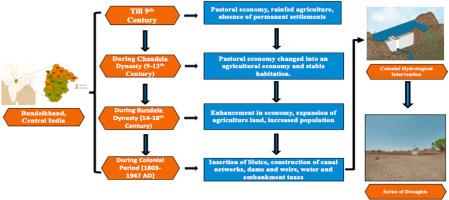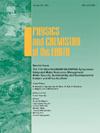回顾过去,展望未来:对印度中部邦德尔坎德邦水资源状况的探索
IF 3
3区 地球科学
Q2 GEOSCIENCES, MULTIDISCIPLINARY
引用次数: 0
摘要
目前,印度正遭受其历史上最严重的水危机,数百万人的生命和生计受到威胁。根据 NITI Aayog 的《水指数报告(2018 年)》,到 2030 年,40% 的人口将无法获得饮用水。脚踏实地组织(DTE)2016 年的一份报告指出,2006 年至 2015 年间,印度中部邦德尔坎德邦建造了 11.6 万个集水结构,并花费了 1.5 万亿卢比用于抗旱措施。尽管如此,在过去 15 年中,该地区仍连续 15 次颗粒无收,发生了 13 次干旱。伊丽莎白-惠特科姆(Elizabeth Whitcombe)、罗汉-德索萨(Rohan D'Souza)等水历史学家证明了英帝国主义如何导致传统集水结构和系统被取代,严重改变了现有的水社会关系。相反,伊恩-斯通(Ian Stone)、戴维-莫斯(David Mosse)和艾莎-沙(Esha Shah)则认为,"殖民前平衡 "与 "殖民水文学 "的框架过于夸张。在此背景下,研究揭示了各种原因和变量的纠结根源,并为政策界应对当代水问题和挑战以及实现可持续发展目标 6:清洁水和卫生提供了实际信息。本文章由计算机程序翻译,如有差异,请以英文原文为准。

Looking back to look forward: Explorations on water scenario in Bundelkhand, Central India
At present, India is suffering from the worst water crisis in its history, and millions of lives and livelihoods are under threat. As per NITI Aayog's Water Index Report (2018), 40% of the population will have no access to drinking water by 2030. A 2016 report by Down To Earth (DTE) stated that 116,000 water harvesting structures were constructed between 2006 and 2015, and 15,000 crore rupees were spent on drought-proofing measures in Bundelkhand, Central India. Still, the region had 15th consecutive crop loss and 13 droughts in the past 15 years. Water historians like Elizabeth Whitcombe, Rohan D'Souza, and others have demonstrated how British imperialism led to the replacement of traditional water harvesting structures and systems, severely altering existing water-society relationships. On the contrary, Ian Stone, David Mosse, and Esha Shah argued that the ‘pre-colonial equilibrium’ versus ‘colonial hydrology’ framework is an exaggeration. Within this context, the research reveals the tangled roots of various causes and variables, and practically informing policy circles to tackle contemporary water issues and challenges and achieve SDG 6: Clean Water and Sanitation.
求助全文
通过发布文献求助,成功后即可免费获取论文全文。
去求助
来源期刊

Physics and Chemistry of the Earth
地学-地球科学综合
CiteScore
5.40
自引率
2.70%
发文量
176
审稿时长
31.6 weeks
期刊介绍:
Physics and Chemistry of the Earth is an international interdisciplinary journal for the rapid publication of collections of refereed communications in separate thematic issues, either stemming from scientific meetings, or, especially compiled for the occasion. There is no restriction on the length of articles published in the journal. Physics and Chemistry of the Earth incorporates the separate Parts A, B and C which existed until the end of 2001.
Please note: the Editors are unable to consider submissions that are not invited or linked to a thematic issue. Please do not submit unsolicited papers.
The journal covers the following subject areas:
-Solid Earth and Geodesy:
(geology, geochemistry, tectonophysics, seismology, volcanology, palaeomagnetism and rock magnetism, electromagnetism and potential fields, marine and environmental geosciences as well as geodesy).
-Hydrology, Oceans and Atmosphere:
(hydrology and water resources research, engineering and management, oceanography and oceanic chemistry, shelf, sea, lake and river sciences, meteorology and atmospheric sciences incl. chemistry as well as climatology and glaciology).
-Solar-Terrestrial and Planetary Science:
(solar, heliospheric and solar-planetary sciences, geology, geophysics and atmospheric sciences of planets, satellites and small bodies as well as cosmochemistry and exobiology).
 求助内容:
求助内容: 应助结果提醒方式:
应助结果提醒方式:


